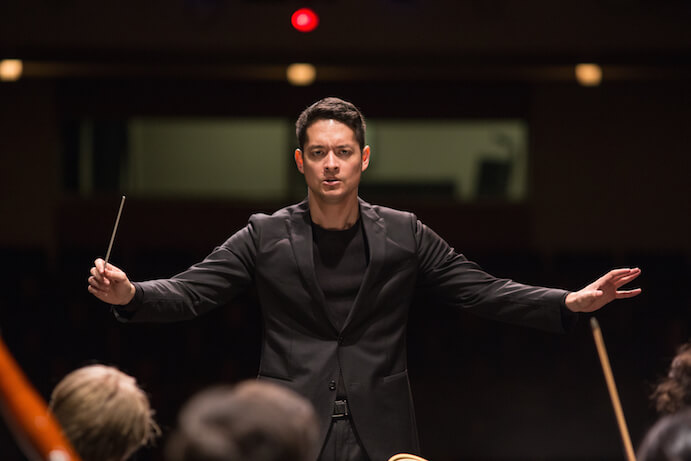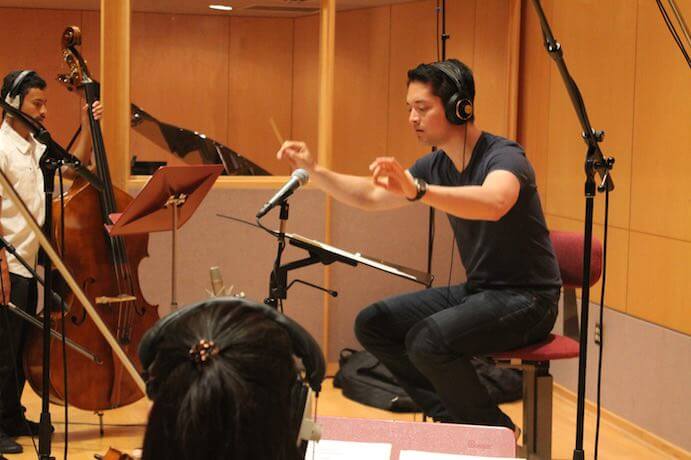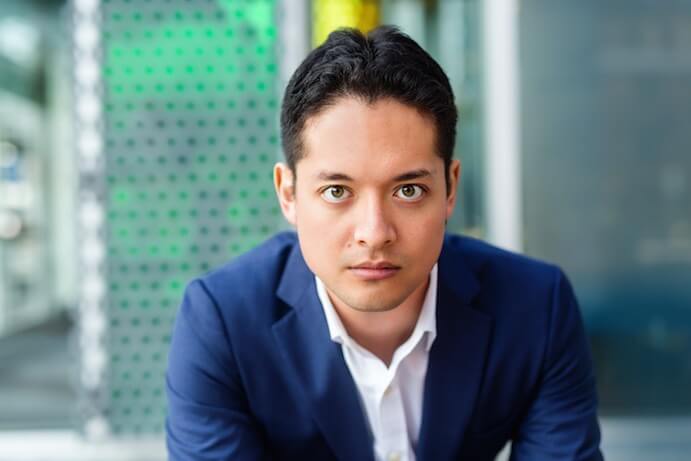Yuga Cohler has garnered attention as a conductor for brilliant performances and an organizer of highly inquisitive, and at times bold, performance projects. His membership in the Asia/America New Music Institute (AANMI) an organization dedicated “to promoting new music relationship between Asia and the Americas,” is yet another instantiation of these qualities.
Featuring the AANMI Los Angeles ensemble under Cohler’s direction, AANMI’s recent debut album, Transcendent, showcases works by member composers across Asia and North America performed by violinist Ryu Goto, bass-baritone Davóne Tines. We asked five questions to Cohler to discover more about this project as well as its place within the transcultural mission of the AANMI.
Could you briefly describe your involvement with the Asia/America New Music Institute (AANMI) over the years and how the Institute’s newly released album, Transcendent, came to be?
AANMI came to be through a variety of connections. Chad Cannon, the founder, and I went to Harvard together, where we were both part of the music scene. Chad had spent several years living in Japan and became fluent in Japanese throughout college. As I am Japanese-American, we naturally shared common perspectives on the development of modern classical music in Asia.
In 2011, we both went on to master’s programs at The Juilliard School. There, we met composers Sayo Kosugi and Sun-Young Park. We all felt that there was a common aesthetic emerging out of the Asian-American compositional world, transcending national boundaries–a language that is lyrical, unacademic, and multicultural–and wanted to create a collective that fostered exchange through this exciting new music. That’s how AANMI was born in 2013.
Since then, we’ve performed and given workshops in Beijing, Tianjin, Shenyang, Tokyo, Okinawa, Hiroshima, Hanoi, Bangkok, Seoul, Los Angeles, and New York, among other places. At a certain point, we realized that the music we were creating and performing was of a high enough caliber that it deserved to be documented, so we decided to make Transcendent. We reached out to violinist Ryu Goto and bass-baritone Davóne Tines–both of whom also went to Harvard with Chad and me, and have been AANMI collaborators since the very beginning–and gathered in Los Angeles for two separate weeks to record.

Yuga Cohler
How does Transcendent represent the AANMI’s mission to promote new musical relationships between Asia and the Americas?
Transcendent contains some of the “greatest hits” of the first five years of our existence. The pieces, while not always sonically similar, all exemplify our aesthetic. So, in a certain sense, the album is itself a musical argument: we wanted to show that the diversity of content in these compositions could itself be a unifying factor.
For example, on the surface, Xiaogang Ye’s Lamura Cuo and Matthew Aucoin’s A Clear Midnight are very different. The former is a violin concerto written by a Chinese composer, drawing its inspiration from a Tibetan lake; the latter is an art song based on a Whitman poem by an American composer. Yet, both pieces end up being about introspection, evoke spiritual equilibrium, and share a meditative air about them that goes beyond their specific notes and harmonies.
It’s worth noting that our soloists Ryu and Davóne have really helped champion our cause by embodying what you might call the “voice” of our philosophy. Having a single voice at the nexus of the composer, conductor, ensemble members, and audience helps distill our musical approach into a relatable way for our audience. Regardless, our hope is that through these thematic elements, Transcendent makes clear the existence of this developing cadre of contemporary classical musicians who are strengthening the musical ties between Asia and America.
You recently completed a tour of Japan with AANMI which included a variety of concert programs and outreach events. How does this kind of touring establish and foster long term relationships between countries and cultures?
On tours, the exchange is very much on a person-to-person basis. Many of the experiences that happen on AANMI tours are first-time ones, whether it be performers traveling to a country, composers working with performers from a certain place, or high school students attending a contemporary music performance.
On this last tour, we were fortunate enough to take Hub New Music with us, and it was all four members’ first time to Japan. We got to work with students from both Kyoto Horikawa Music High School and Hiroshima University. These experiences provided the students exposure not just to high-level contemporary music performance, but also the cultural practices of American musicians; conversely, it gave AANMI members insight into what Japanese music education looks like.
One of the most special stops on the tour was the Tenmangu Shrine in Fukuoka, one of the most important holy sites in Japan. There, we got to perform our repertoire in the sanctuary facing towards the temple, which meant that our concert was literally an offering to the Gods. This wasn’t just an instance of bidirectional cultural exchange, it was one of bidirectional cultural influence–I think it’s very possible that this was the first time that contemporary classical music was rendered a holy gift at such a prominent place of worship in Japan.

Yuga Cohler
The liner notes for Transcendent describe the works curated as, “music that, while rooted in the instrumental and vocal traditions of the West, firmly declares a new era of artistic achievement and diversity.” Can you expound upon what diversity means in the context of this album, for AANMI generally, and how the group plans to continue to cultivate diversity in the future?
Diversity means a lot of things to us. It certainly means diversity of musical style: we don’t subscribe to any particular compositional creed or performative approach. But it also means diversity of thought and background.
We are interested in featuring unique voices who exhibit the wide range of cultural experiences that exist in Asia and America, and we want to create connections between them. For example, on our recent tour to Japan, composer Carlos Simon explained to our audiences on several occasions that he draws inspiration for his music from the spirituals sung by his enslaved ancestors. For many of the Japanese people attending, it was probably their first time hearing from an African-American about the legacy of slavery and its impact on their culture.
Our goal is to bring a wide slate of musicians to a multitude of different settings. While our work has generally been focused in South Korea, China, and Japan, we would like to go more regularly to Southeast and South Asia, perhaps eventually even to North Korea. We want to create more opportunities to reaffirm our common humanity through musical exchange.
In your projects outside of AANMI, particularly Yeethoven, finding common ground between genres and the audiences that support them appears to be a common theme. Do you have any wisdom for musicians, composers, artists, and curators who want to use music to foster exchange between communities and cultures?
“Wisdom” is probably too strong a word. I prefer the term “hypothesis,” because it obligates you to support your insight with evidence. For instance, if you want to foster exchange between two communities, but you put on your concert and one of those communities doesn’t actually show up, then you need to adjust your hypothesis. The hypothesis also has to initially make sense–there has to be some insight or intuition that makes the hypothesis feel right from the start.
Every project for me is the testing of a hypothesis about the audience I want to engage with. With Yeethoven, for example, the hypothesis was that fans of Kanye West (of which I am one) would enjoy Beethoven more if they understood the common musical elements their works shared. This felt right to me because Kanye fans tend not just to enjoy his music, but also hold him in high regard for his sophisticated artistic approach. With AANMI, the implicit hypothesis is that there is a substantial, growing population of contemporary composers and performers whose values are in line with our musical aesthetic.
I’ve found that this scientific approach works well for me. It gives me a framework within which to operate and allows me to quickly shift gears and adjust when things don’t work. I think it would benefit people in the arts to be more empirical than dogmatic in their work–try to figure out what it is the audience actually wants, and then give that to them.




















